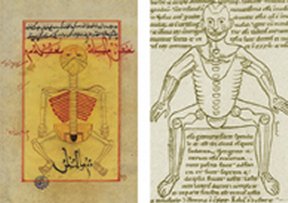- More than 2 years ago
Through the ages, innumerable texts have been consumed by fire, war, theft, and other disasters. Each ancient or medieval manuscript in existence today has its own story of survival against the odds, whether the document was tucked away in an obscure monastery for a millennium or stolen by Vikings and passed from collector to collector. Manuscript experts have long puzzled over the question, what fraction of ancient works has survived?

Paleontologist John Cisne of Cornell University brings a fresh approach to this problem. He regards handwritten medieval manuscripts as fossils from an extinct population. Using equations from population biology, he has created a mathematical model that suggests, happily, that we have at least fragments of the majority of popular medieval titles.
“It looks as if we’ve got a representative sample of the books in circulation 1,000 or 1,200 years ago, not just a few rare flukes,” Cisne says.
Until the invention of the printing press in the 15th century, reproduction of manuscripts had a lot in common with replication of organisms, Cisne argues. Each new manuscript had to be transcribed from an existing “parent” copy, so the more copies in circulation, the more new ones that could be produced. Cisne hypothesized that the number of copies of a given text should grow according to population biology’s logistic model: The population would at first increase exponentially, as cliché rabbits do, then gradually level out as it approached the maximum number of organisms that the environment could sustain. For manuscripts, that would be the number of libraries and individuals who wanted a copy.
To test this model, Cisne examined four scientific texts by the Venerable Bede, an 8th-century scholar who is one of the most thoroughly cataloged of medieval authors. By looking at how many copies of his works survive today and in which century, from the 8th to the 15th, each was produced, Cisne found that these texts do indeed fit the logistic model. He describes his work in the Feb. 25 Science.
Numbers game
With his model, Cisne estimates that the likelihood that a popular medieval text would have gone extinct between its creation and the present day is less than 7 percent. This estimate fits well with the availability of the Bede’s other works. Of his 35 known books, 32 have survived in some form.
“The numbers are in the right ballpark,” Cisne says.
“It’s very exciting work,” says Florence Eliza Glaze, a historian of medieval medicine at Coastal Carolina University in Conway, S.C. “Classical scholars tend to work with anecdotal evidence, and most of us don’t do statistical analyses. This is a great opportunity to get people talking across disciplines.”
Glaze cautions that while the new model works well for the four scientific works that Cisne studied, it makes many assumptions that will probably work less well for other texts. One problem is that Cisne assumes that manuscripts have a constant death rate, whereas the destruction of manuscripts tends to be highly episodic. For instance, many manuscripts were burned during the dissolution of the English monasteries in the 16th century, for example, and others were destroyed during the French Revolution, when the revolutionaries used manuscript parchment for rifle cartridges.
Cisne agrees with this caveat. “I specifically looked at Bede’s scientific works because they looked like idealized cases where the model might apply,” he says. They were widely owned by the clergy, the educated elite, and the commercial classes and had no political or religious content that might lead them to be targeted for destruction.
When Cisne applied his model to Bede’s Ecclesiastical History of the English People, which was held primarily by monasteries, the equations failed to capture the book’s population dynamics. Cisne is now looking for ways to refine the model to deal with such situations.
“This is how science works—you find a first-order model that works in simple situations, then go on to look at complex situations and see if the model can be modified,” Cisne says.
Lost in translation
Other analogies between organisms and manuscripts may be worth exploring, Cisne says. The world of books has its own versions of invasive species and mutations, for instance. In 12th-century Spain, early medieval geometry textbooks quickly became obsolete after state-of-the-art Arabic volumes arrived on the scene. Furthermore, every time a scribe copied a manuscript, he inevitably introduced small errors. Scholars of ancient texts use many of the same techniques that evolutionary biologists do when investigating which manuscripts predate others and what the original version must have said.
To study evolution of both organisms and manuscripts, Cisne is now using tools from information theory, which considers transmission errors in information. He is examining medieval geometry manuscripts, where it’s usually possible to identify scribes errors.
“I want to get at how secure a mechanism of information transmission it is to have scribes copying manuscripts,” he says. “How much gets lost in transcription? I think that’s a very promising area to explore.”






